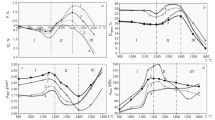The effect of firing temperature in the range 800 – 1640°C on the change in phase composition, structure, and some properties of specimen materials prepared on the basis of composite composition HCBS is studied. Four temperature ranges are stablished by a dilatometric method with a nonisothermal heating rate of 300°C/h corresponding to normal thermal expansion (up to 800°C), sintering accompanied by shrinkage (800 – 1150°C), mullitization accompanied by growth (1150 – 1400°), and sintering of mullitized material (1400 – 1500°C). A set of methods is used (XPA, dilatometric analysis, optical, and electron microscopy) to specify the phase composition and material structure in the firing temperature ranges noted. After firing at 1400 – 1640°C the material contains 38 – 42% mullite, 50 – 55% corundum, and balance glass phase and titanium compounds.








Similar content being viewed by others
References
Yu. E. Pivinskii, P. V. Dyakin, and L. V. Ostryakov, “Research in the field of preparing molded and unmolded refractories based on high-alumina HCBS. Part 3. Effect of firing temperature on sintering and mullitization of materials prepared on the basis îf composite HCBS,” Refract. Indust. Ceram., 56(6), 648 – 655 (2015).
Yu. E. Pivinskii and P. V. Dyakin, “Research in the field of preparing molded and unmolded refractories based on high-alumina HCBS. Part 4. Effect of refractory clay addition on properties of compound composition HCBS, castings and matårials based on them,” Refract. Indust. Ceram., 57(1), 70 – 76 (2016).
Yu. E. Pivinskii, P. V. Dyakin, and L. V. Ostryakov, “Research in the field of preparing molded and unmolded refractories based on high-alumina HCBS. Part 5. Effect of firing temperature on properties of materials prepared from composite HCBS with addition of refractory clay,” Refract. Indust. Ceram., 57(2), 180 – 184 (2016).
Yu. E. Pivinskii, P. V. Dyakin, and A. Yu. Kolobov, “Research in the field of preparing molded and unmolded refractories based on high-alumina HCBS. Part 6. Mullitization and thermal expansion of materials based on compound composition HCBS,” Refract. Indust. Ceram., 57(3), 297 – 303 (2016).
Yu. E. Pivinskii, P. V. Dyakin, and A. Yu. Kolobov, “Research in the field of preparing molded and unmolded refractories based on high-alumina HCBS. Part 9. Preparation and properties of mixed HCBS composition: fuzed bauxite-corundum, quartz glass, reactive alumina. Dilatometric study of materials based on them,” Refract. Indust. Ceram., 58(1), 103 – 108 (2017).
Yu. E. Pivinskii, “Research in the field of preparing molded and unmolded refractories based on high-alumina HCBS. Part 12. Composite composition HCBS: bauxite, electrocorundum, quartz glass, and some properties of materials based on them,” Novye Ogneupory, No. 10, 15 – 21 (2017).
Yu. E. Pivinskii and P. V. Dyakin, “Research in the field of preparing molded and unmolded refractories based on high-alumina HCBS. Part 7. Sintering and secondary mullite formation of material based on composite-composition HCBS during thermal heating and isothermal heating,” Refract. Indust. Ceram., 57(5), 536 – 544 (2016).
Yu. E. Pivinskii, P. V. Dyakin, A. M. Gorokhovskii, and L.V. Ostryakov, “Research in the field of preparing molded and unmolded refractories based on high-alumina HCBS. Part 10. Effect of firing temperature on properties of materials prepared based on mixed composition HCBS from fuzed bauxite-corundum, quartz glass and reactive alumina,” Refract. Indust. Ceram., 58(2), 227 – 232 (2017).
Yu. E. Pivinskii and E. I. Suzdal’tsev, Quartz ceramic and Refractories. Vol. 1. Teoretical Base and Production Processes (Yu. E. Pivinskii, editor) [in Russian], Teploenergetik, Moscow (2008).
Yu. E. Pivinskii, P. V. Dyakin, and A. Yu. Kolobov, “Pivinskii, Yu. E. Research in the area of preparing materials based on fuzed quartz HCBS. Part 10. Some properties of cristobalite containing materials,” Refract. Indust. Ceram., 57(3), 252 – 257 (2016).
Yu. E. Pivinskii and P. V. Dyakin, ”Research in the field of preparing molded and unmolded refractories based on high-alumina HCBS. Part 8. Effect of firing temperature on properties of materials based on mixed HCBS composition bauxite, quartz glass and reactive alumina,” Refract. Indust. Ceram., 57(6), 637 – 644 (2017).
Yu. E. Pivinskii, P. V. Dyakin, and A. Yu. Kolobov, “Research in the field of preparing molded and unmolded refractories based on high-alumina HCBS. Part 11. Composite composition HCBS: fuzed corundum, bauxite, sintered bauxite, quartz glass, and some properties of materials based on them, Novye Ogneupory, No. 8, 57 – 63 (2017).
N. T. Andrianov and E. S. Lukin, Ceramic Thermal Ageing [in Russian], Metallurgiya, Moscow (1979).
N. T. Andrianov and V. L. Malkevich, A. V. Belyakov, et al., Ceramic Chemical Technology (I. Ya. Guzman, editor) [in Russian], RIF Stroimaterialy, Moscow (2012).
V. S. Bakunov, A. V. Belyakov, E. S. Lukin, and U. Sh. Shayakhmetov, Oxide ceramics: Sintering Creep [in Russian], RKhTU imeni D. I. Mendeleeva, Moscow (2007).
Author information
Authors and Affiliations
Corresponding author
Additional information
1Continuation. Parts 1 – 3 of the article were published in Novye Ogneupory Nos. 8, 10, and 12 (2015), parts 4 – 8 in Nos 2, 4, 6, 10, and 12 (2016), and parts 9 – 12 in Nos. 2, 4, 8 and 10 (2017).
Translated from Novye Ogneupory, No.12, pp. 27 – 35, December, 2017.
Rights and permissions
About this article
Cite this article
Pivinskii, Y.E., Perepelitsyn, V.A., Dyakin, P.V. et al. Research in the Field of Preparing Molded and Unmolded Refractories Based on High-Alumina HCBS. Part 13. Effect of Firing Temperature on Phase Composition, Structure, and Some Properties of Materials Based on Composite Composition HCBS (Bauxite, Electrocorundum, Quartz Glass)1. Refract Ind Ceram 58, 652–659 (2018). https://doi.org/10.1007/s11148-018-0163-y
Received:
Published:
Issue Date:
DOI: https://doi.org/10.1007/s11148-018-0163-y




